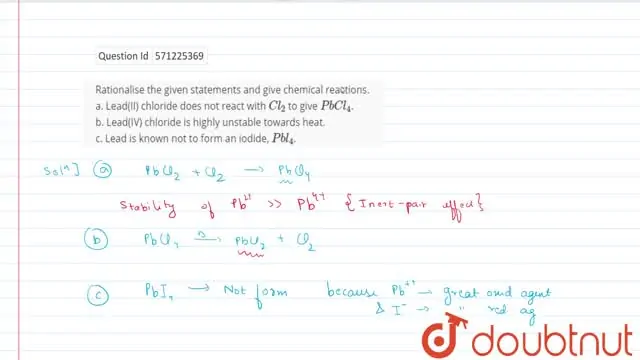Rationalise the given statements and give chemical reactions.
a. Lead(II) chloride does not react with Cl2 to give PbCl4.
b. Lead(IV) chloride is highly unstable towards heat.
c. Lead is known not to form an iodide, Pbl4.
(a) Lead belongs to group 14 of the periodic table. The two oxidation states displayed by this group is +2 and| +4. On moving down the group, the +2 oxidation state becomes more stable and the +4 oxidation state becomes less stable. This is because of the inert pair effect. Hence, PbCl4 is much less stable than PbCl2. However, the formation of PbCl4 takes place when chlorine gas is bubbled through a saturated solution of PlCl2.
PbCl2(s)+Cl2(g)→PbCl4(l)
(b) On moving down group IV, the higher oxidation state becomes unstable because of the inert pair effect. Pb(IV) is highly unstable and when heated, it reduces to Pb(II).
PbCl4(l)Δ−−→PbCl2(s)+Cl2(g)
(c) Lead is known not to form PbI4. Pb (+4) is oxidising in nature and I− is reducing in nature. A combination of Pb(IV) and iodide ion is not stable. Iodide ion is strongly reducing in nature. Pb(IV) oxidises I– to I2 "and itself gets reduced to Pb(II)".
PbI4→Pbl2+I2
Related Playlists
Similar Questions
Tin and lead form divalent Sn (II) and ead (II) and tetravalent i.e., Tin (IV) and lead. (IV) compounds. Tetravalent and dioxides of lead and Tin are amphoteric in nature. Lead tetra fluorite is ionic solid where as PbCl4 is covalent. Pbl4 does not exist. lead (II) halides are white whereas Pbl2 is yellow in colour.
Q. Pbl4 does not exist due toView SolutionTin and lead form divalent Sn (II) and lead (II) and tetravalent i.e., Tin (IV) and lead. (IV) compounds. Tetravalent and dioxides of lead and Tin are amphoteric in nature. Lead tetra fluorite is ionic solid where as PbCl4 is covalent. Pbl4 does not exist. lead (II) halides are white whereas Pbl2 is yellow in colour.
Q. SnCl2 is solid whereas SnCl4 is liquid, this is because?View SolutionTin and lead form divalent Sn (II) and lead (II) and tetravalent i.e., Tin (IV) and lead. (IV) compounds. Tetravalent and dioxides of lead and Tin are amphoteric in nature. Lead tetra fluorite is ionic solid where as PbCl4 is covalent. Pbl4 does not exist. Lead (II) halides are white whereas Pbl2 is yellow in colour.
Q. Reaction of SnO with NaOH givesView SolutionWrite the balanced chemical equations for the following reactions and identify the type of reaction in each case.
(a) Iron (III) oxide reacts with aluminium and gives molten iron and aluminium oxide.
(b) Magnesium ribbon is burnt in an atmosphere of nitrogen gas to form solid magnesium nitride.
(c) Chlorine gas is passed in an aqueous potassium iodide solution to form potassium chloride solution and solid iodine.
(d) Ethanol is burnt in air to form carbon dioxide, water and releases heat.View SolutionWrite the balanced chemical equations for the following reaction.
(a) Sodium carbonate on reaction with hydrochloric acid in equal molar concentrations gives sodium chloride and sodium hydrogen carbonate.
(b) Sodium hydrogen carbonate on reaction with hydrochloric acid gives sodium chloride, water and liberates carbon dioxide.
(c) Copper sulphate on treatment with potassium iodide precipitates cuprous iodide iodide (Cu2I2), liberates iodine gas and also forms potassium sulphate.View SolutionWrite chemical equations for the following reactions:
(i) Reaction of ethanolic NH3 with C2H5Cl.
(ii) Ammonolysis of benzyl chloride and reaction of amine so formed with two moles of CH3Cl.View SolutionHow many moles of lead (II) chloride will be formed from a reaction between 6.5 g of PbO and 3.2 g of HCl?
View SolutionWhat happens when : (write only chemical reactions)
(a) Hydrogen Sulphide is treated with Sulphur dioxide.
(b) carbondioxide is passed through a concertrated aqueous solution of sodium chloride saturated with ammonia.
( c) red lead is treated with nitric acid.
(d) dilute nitric acid is slowly reacted with tin.View SolutionAn organic compound (A) C4H9Cl on reacting with aqueous KOH gives (B) and on reaction with alcoholic KOH gives (C ), which is also formed on passing the vapours of (B) over the heated copper. The compound (C ) readily decolourises bromine water. Ozonolysis of (C ) gives two compounds (D) and (E ). Compound (D) reacts with NH2OH to give (F) and compound (E ) reacts with NaOH to have an alcohol (G) and sodium salt (H) of an acid. (D) can also be prepared form propyne on treatment with water in the presence of Hg2+ and H2SO4. Identify (A) to (H) with proper reasoning.
View SolutionCompund (A), C5H11NO is not soluble in cold alkaline or acidic solutions. When (A) is refluxed in NaOH solution, a gas (B) is evolved and salt (C) is formed. Acetyl chloride reacts with (B) to give (D), (C4H9NO). (B) reacts with HNO2 to give a yellow oil (E). Give structures of (A) to (E) with reason.
View Solution


